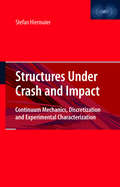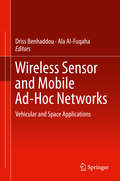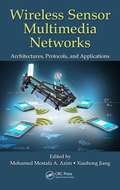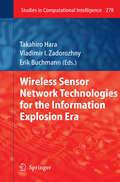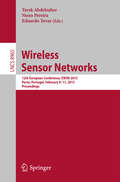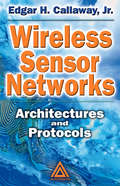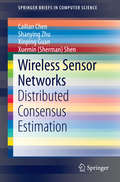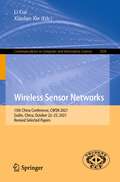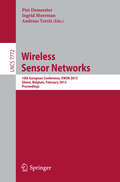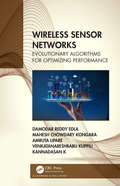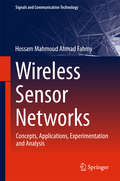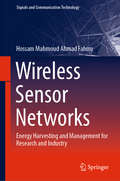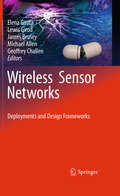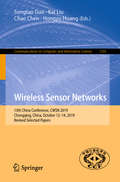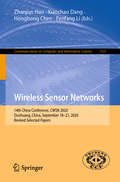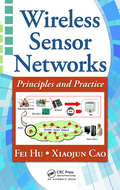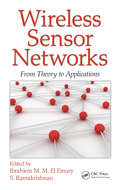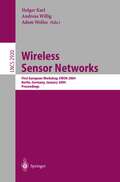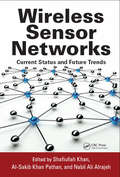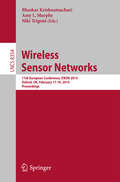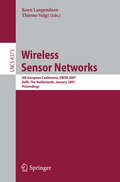- Table View
- List View
Wireless Sensor and Actor Networks II: Proceedings of the 2008 IFIP Conference on Wireless Sensor and Actor Networks (WSAN 08), Ottawa, Ontario, Canada, July 14-15, 2008 (IFIP Advances in Information and Communication Technology #264)
by Ali MiriThis book constitutes the refereed proceedings of the IFIP Conference on Wireless Sensors and Actor Networks held in Ottawa, Canada, July, 2008. This series publishes state-of-the-art results in the sciences and technologies of information and communication. The scope of the series includes: foundations of computer science; software theory and practice; education; computer applications in technology; communication systems; systems modeling and optimization; information systems; computers and society; computer systems technology; security and protection in information processing systems; artificial intelligence; and human-computer interaction. Proceedings and post-proceedings of refereed international conferences in computer science and interdisciplinary fields are featured. These results often precede journal publication and represent the most current research. The principal aim of the IFIP series is to encourage education and the dissemination and exchange of information about all aspects of computing.
Wireless Sensor and Mobile Ad-Hoc Networks: Vehicular and Space Applications
by Driss Benhaddou Ala Al-FuqahaWireless sensor Networks: Vehicle and Space Applications describes the practical perspectives in using wireless sensor networks (WSN) to develop real world applications that can be used for space exploration. These applications include sensor interfaces, remote wireless vehicles, space crew health monitoring and instrumentation. The material discusses how applications of WSN originally developed for space travel and exploration are being applied and used in multiple real world applications, allowing for the development of smart systems that have characteristics such as self healing, self diagnosis, and emergency healthcare notification.
Wireless Sensor Multimedia Networks: Architectures, Protocols, and Applications
by Mohamed Mostafa A. Azim Xiaohong JiangWireless sensor networks (WSNs) are a special class of ad hoc network in which network nodes composed of tiny sensors pass data such as temperature, pressure, and humidity through the network to a central location. Wireless sensor multimedia networks (WSMNs) are a special category of WSNs in which the sensor nodes are small cameras and microphones
Wireless Sensor Multimedia Networks: Architectures, Protocols, and Applications
by Mohamed Mostafa A. Azim Xiaohong JiangWireless sensor networks (WSNs) are a special class of ad hoc network in which network nodes composed of tiny sensors pass data such as temperature, pressure, and humidity through the network to a central location. Wireless sensor multimedia networks (WSMNs) are a special category of WSNs in which the sensor nodes are small cameras and microphones
Wireless Sensor Network Technologies for the Information Explosion Era (Studies in Computational Intelligence #278)
by Takahiro Hara Vladimir I. Zadorozhny Erik BuchmannWireless Sensor Network Technologies for Information Explosion Era The amount and value of information available due to rapid spread of information technology is exploding. Typically, large enterprises have approximately a petabyte of operational data stored in hundreds of data repositories supporting thousands of applications. Data storage volumes grow in excess of 50% annually. This growth is expected to continue due to vast proliferation of existing infor- tion systems and the introduction of new data sources. Wireless Sensor Networks (WSNs) represent one of the most notable examples of such new data sources. In recent few years, various types of WSNs have been deployed and the amount of information generated by wireless sensors increases rapidly. The information - plosion requires establishing novel data processing and communication techniques for WSNs. This volume aims to cover both theoretical and practical aspects - lated to this challenge, and it explores directions for future research to enable ef- cient utilization of WSNs in the information-explosion era. The book is organized in three main parts that consider (1) technical issues of WSNs, (2) the integration of multiple WSNs, and (3) the development of WSNs systems and testbeds for conducting practical experiments. Each part consists of three chapters.
Wireless Sensor Networks: 12th European Conference, EWSN 2015, Porto, Portugal, February 9-11, 2015, Proceedings (Lecture Notes in Computer Science #8965)
by Tarek Abdelzaher Nuno Pereira Eduardo TovarThis book constitutes the refereed proceedings of the 12 European Conference on Wireless Sensor Networks, EWSN 2015, held in Porto, Portugal, in February 2015. The 14 full papers and 9 short papers presented were carefully reviewed and selected from 85 submissions. They cover a wide range of topics grouped into five sessions: services and applications, mobility and delay-tolerance, routing and data dissemination, and human-centric sensing.
Wireless Sensor Networks: Architectures and Protocols (Internet And Communications Ser.)
by Jr., Edgar CallawayBecause they provide practical machine-to-machine communication at a very low cost, the popularity of wireless sensor networks is expected to skyrocket in the next few years, duplicating the recent explosion of wireless LANs. Wireless Sensor Networks: Architectures and Protocols describes how to build these networks, from the layers of the
Wireless Sensor Networks: Architectures and Protocols
by Jr., Edgar CallawayBecause they provide practical machine-to-machine communication at a very low cost, the popularity of wireless sensor networks is expected to skyrocket in the next few years, duplicating the recent explosion of wireless LANs. Wireless Sensor Networks: Architectures and Protocols describes how to build these networks, from the layers of the
Wireless Sensor Networks: Distributed Consensus Estimation (SpringerBriefs in Computer Science)
by Cailian Chen Shanying Zhu Xinping Guan Xuemin (Sherman) ShenThis SpringerBrief evaluates the cooperative effort of sensor nodes to accomplish high-level tasks with sensing, data processing and communication. The metrics of network-wide convergence, unbiasedness, consistency and optimality are discussed through network topology, distributed estimation algorithms and consensus strategy. Systematic analysis reveals that proper deployment of sensor nodes and a small number of low-cost relays (without sensing function) can speed up the information fusion and thus improve the estimation capability of wireless sensor networks (WSNs). This brief also investigates the spatial distribution of sensor nodes and basic scalable estimation algorithms, the consensus-based estimation capability for a class of relay assisted sensor networks with asymmetric communication topology, and the problem of filter design for mobile target tracking over WSNs. From the system perspective, the network topology is closely related to the capability and efficiency of network-wide scalable distributed estimation. Wireless Sensor Networks: Distributed Consensus Estimation is a valuable resource for researchers and professionals working in wireless communications, networks and distributed computing. Advanced-level students studying computer science and electrical engineering will also find the content helpful.
Wireless Sensor Networks: 15th China Conference, CWSN 2021, Guilin, China, October 22–25, 2021, Revised Selected Papers (Communications in Computer and Information Science #1509)
by Li Cui Xiaolan XieThis book constitutes the refereed proceedings of the 15th China Conference on Wireless Sensor Networks, CWSN 2021 held in Guilin, China, in October 2021.The 19 papers were carefully reviewed and selected from 60 submissions. The papers are organized in topical sections on theory and technology on wireless sensor network; application on internet of things; security and privacy protection on internet of things; fog computing and wireless computing.
Wireless Sensor Networks: 10th European Conference, EWSN 2013, Ghent, Belgium, February 13-15, 2013, Proceedings (Lecture Notes in Computer Science #7772)
by Piet Demeester Ingrid Moerman Andreas TerzisThis book constitutes the refereed proceedings of the 10th European Conference on Wireless Sensor Networks, EWSN 2013, held in Ghent, Belgium, in February 2013. The 12 revised full papers presented were carefully reviewed and selected from 51 submissions. The papers cover a wide range of topics in the following areas: experimentation and data access; data management; network algorithms and protocols; and physical layer and hardware aspects.
Wireless Sensor Networks: Evolutionary Algorithms for Optimizing Performance
by Damodar Reddy Edla Mahesh Chowdary Kongara Amruta Lipare Venkatanareshbabu Kuppili Kannadasan KWireless Sensor Networks: Evolutionary Algorithms for Optimizing Performance provides an integrative overview of bio-inspired algorithms and their applications in the area of Wireless Sensor Networks (WSN). Along with the usage of the WSN, the number of risks and challenges occurs while deploying any WSN. Therefore, to defeat these challenges some of the bio-inspired algorithms are applied and discussed in this book. Discussion includes a broad, integrated perspective on various challenges and issues in WSN and also impact of bio-inspired algorithms on the lifetime of the WSN. It creates interdisciplinary theory, concepts, definitions, models and findings involved in WSN and Bio-inspired algorithms making it an essential guide and reference. It includes various WSN examples making the book accessible to a broader interdisciplinary readership. The book offers comprehensive coverage of the most essential topics, including: Evolutionary algorithms Swarm intelligence Hybrid algorithms Energy efficiency in WSN Load balancing of gateways Localization Clustering and routing Designing fitness functions according to the issues in WSN. The book explains about practices of shuffled complex evolution algorithm, shuffled frog leaping algorithm, particle swarm optimization and dolphin swarm optimization to defeat various challenges in WSN. The author elucidates how we must transform our thinking, illuminating the benefits and opportunities offered by bio-inspired approaches to innovation and learning in the area of WSN. This book serves as a reference book for scientific investigators who shows an interest in evolutionary computation and swarm intelligence as well as issues and challenges in WSN.
Wireless Sensor Networks: Evolutionary Algorithms for Optimizing Performance
by Damodar Reddy Edla Mahesh Chowdary Kongara Amruta Lipare Venkatanareshbabu Kuppili Kannadasan KWireless Sensor Networks: Evolutionary Algorithms for Optimizing Performance provides an integrative overview of bio-inspired algorithms and their applications in the area of Wireless Sensor Networks (WSN). Along with the usage of the WSN, the number of risks and challenges occurs while deploying any WSN. Therefore, to defeat these challenges some of the bio-inspired algorithms are applied and discussed in this book. Discussion includes a broad, integrated perspective on various challenges and issues in WSN and also impact of bio-inspired algorithms on the lifetime of the WSN. It creates interdisciplinary theory, concepts, definitions, models and findings involved in WSN and Bio-inspired algorithms making it an essential guide and reference. It includes various WSN examples making the book accessible to a broader interdisciplinary readership. The book offers comprehensive coverage of the most essential topics, including: Evolutionary algorithms Swarm intelligence Hybrid algorithms Energy efficiency in WSN Load balancing of gateways Localization Clustering and routing Designing fitness functions according to the issues in WSN. The book explains about practices of shuffled complex evolution algorithm, shuffled frog leaping algorithm, particle swarm optimization and dolphin swarm optimization to defeat various challenges in WSN. The author elucidates how we must transform our thinking, illuminating the benefits and opportunities offered by bio-inspired approaches to innovation and learning in the area of WSN. This book serves as a reference book for scientific investigators who shows an interest in evolutionary computation and swarm intelligence as well as issues and challenges in WSN.
Wireless Sensor Networks: Concepts, Applications, Experimentation and Analysis (Signals and Communication Technology)
by Hossam Mahmoud FahmyThis book focuses on the principles of wireless sensor networks (WSNs), their applications, and their analysis tools, with meticulous attention paid to definitions and terminology. This book presents the adopted technologies and their manufacturers in detail, making WSNs tangible for the reader. In introductory computer networking books, chapter sequencing follows the bottom-up or top-down architecture of the 7-layer protocol. This book addresses subsequent steps in this process, both horizontally and vertically, thus fostering a clearer and deeper understanding through chapters that elaborate on WSN concepts and issues. With such depth, this book is intended for a wide audience; it is meant to be a helper and motivator for senior undergraduates, postgraduates, researchers, and practitioners. It lays out important concepts and WSN-relate applications; uses appropriate literature to back research and practical issues; and focuses on new trends. Senior undergraduate students can use it to familiarize themselves with conceptual foundations and practical project implementations. For graduate students and researchers, test beds and simulators provide vital insights into analysis methods and tools for WSNs. Lastly, in addition to applications and deployment, practitioners will be able to learn more about WSN manufacturers and components within several platforms and test beds.
Wireless Sensor Networks: Energy Harvesting and Management for Research and Industry (Signals and Communication Technology)
by Hossam Mahmoud FahmyThis second book by the author on WSNs focuses on the concepts of energy, and energy harvesting and management techniques. Definitions and terminologies are made clear without leaning on the relaxing assumption that they are already known or easily reachable, the reader is not to be diverted from the main course. Neatly drawn figures assist in viewing and imagining the offered topics. To make energy related topics felt and seen, the adopted technologies as well as their manufacturers are presented in details. With such a depth, this book is intended for a wide audience, it is meant to be helper and motivator, for the senior undergraduates, postgraduates, researchers, and practitioners; concepts and energy related applications are laid out, research and practical issues are backed by appropriate literature, and new trends are put under focus. For senior undergraduate students, it familiarizes with conceptual foundations and practical projects implementations. Also, it is intended for graduate students working on their thesis and in need of specific knowledge on WSNs and the related energy harvesting and management techniques. Moreover, it is targeting researchers and practitioners interested in features and applications of WSNs, and on the available energy harvesting and management projects and testbeds. Exercises at the end of each chapter are not just questions and answers; they are not limited to recapitulate ideas. Their design objective is not bound to be a methodical review of the provided concepts, but rather as a motivator for lot more of searching, finding, and comparing beyond what has been presented in the book.
Wireless Sensor Networks: Deployments and Design Frameworks
by Elena Gaura Michael Allen James Brusey Geoffrey Challen Lewis GirodThe twentieth century ended with the vision of smart dust: a network of wirelessly connected devices whose size would match that of a dust particle, each one a se- containedpackageequippedwithsensing,computation,communication,andpower. Smart dust held the promise to bridge the physical and digital worlds in the most unobtrusive manner, blending together realms that were previously considered well separated. Applications involved scattering hundreds, or even thousands, of smart dust devices to monitor various environmental quantities in scenarios ranging from habitat monitoring to disaster management. The devices were envisioned to se- organize to accomplish their task in the most ef?cient way. As such, smart dust would become a powerful tool, assisting the daily activities of scientists and en- neers in a wide range of disparate disciplines. Wireless sensor networks (WSNs), as we know them today, are the most no- worthy attempt at implementing the smart dust vision. In the last decade, this ?eld has seen a fast-growing investment from both academia and industry. Signi?cant ?nancial resources and manpower have gone into making the smart dust vision a reality through WSNs. Yet, we still cannot claim complete success. At present, only specialist computerscientists or computerengineershave the necessary background to walk the road from conception to a ?nal, deployed, and running WSN system.
Wireless Sensor Networks: 13th China Conference, CWSN 2019, Chongqing, China, October 12–14, 2019, Revised Selected Papers (Communications in Computer and Information Science #1101)
by Songtao Guo Kai Liu Chao Chen Hongyu HuangThis book constitutes the refereed proceedings of the 13th China Conference on Wireless Sensor Networks, CWSN 2019, held in Chongqing, China, in October 2019. The 27 full papers were carefully reviewed and selected from 158 submissions. The papers are organized in topical sections on fundamentals on Internet of Things; applications on Internet of Things; and IntelliSense, location and tracking.
Wireless Sensor Networks: 14th China Conference, CWSN 2020, Dunhuang, China, September 18–21, 2020, Revised Selected Papers (Communications in Computer and Information Science #1321)
by Zhanjun Hao Xiaochao Dang Honghong Chen Fenfang LiThis book constitutes the refereed proceedings of the 14th China Conference on Wireless Sensor Networks, CWSN 2020 held in Dunhuang, China, in September 2020.The 20 full papers were carefully reviewed and selected from 85 submissions. The papers are organized in topical sections on wireless sensor network theory and technology, basic theory and application of internet of things, internet of things security and privacy protection, and perception and positioning.
Wireless Sensor Networks: Principles and Practice
by Fei HuWritten by award-winning engineers whose research has been sponsored by the U.S. National Science Foundation (NSF), IBM, and Cisco's University Research Program, Wireless Sensor Networks: Principles and Practice addresses everything product developers and technicians need to know to navigate the field. It provides an all-inclusive examina
Wireless Sensor Networks: From Theory to Applications
by Ibrahiem M. M. El Emary S. Ramakrishnan Ibrahiem M. M. El EmaryAlthough there are many books available on WSNs, most are low-level, introductory books. The few available for advanced readers fail to convey the breadth of knowledge required for those aiming to develop next-generation solutions for WSNs.Filling this void, Wireless Sensor Networks: From Theory to Applications supplies comprehensive coverage of WS
Wireless Sensor Networks: First European Workshop, EWSN 2004, Berlin, Germany, January 19-21, 2004, Proceedings (Lecture Notes in Computer Science #2920)
by Holger Karl Andreas Willig WoliszWithgreatpleasurewewelcomedtheattendeestoEWSN2004,the1stEuropean Workshop on Wireless Sensor Networks, held in the exciting and lively city of Berlin. Wireless sensor networks are a key technology for new ways of interaction betweencomputersandthephysicalenvironmentwhichsurroundsus.Compared to traditional networking technologies, wireless sensor networks are faced with a rather unique mix of challenges: scalability, energy e?ciency, self-con?guration, constrainedcomputationandmemoryresourcesinindividualnodes,data-cent- city, and interaction with the physical environment, to name but a few. The goal of this workshop is to create a forum for presenting new results in the ?ourishing ?eld of wireless sensor networks. By bringing together academia and industry we hope to stimulate new opportunities for collaborations. In compiling the scienti?c program we have been quite selective. Thanks to the e?orts of 90 reviewers who delivered 252 reviews for the 76 papers originally submitted from all over the world, a strong selection of the 24 best contributions was made possible. The Technical Program Committee created an outstanding program covering the broad scope of this highly interdisciplinary ?eld: from distributed signal processing through networking and middleware issues to - plication experience. Running such a workshop requires dedication and much work from many people. We want to thank in particular Petra Hutt, Irene Ostertag and Heike Klemz for their valuable and esteemed help in the local organization of this workshop. We hope that you enjoy this volume, and if you were lucky enough to - tend we hope that you enjoyed the discussions with colleagues working in this fascinating area.
Wireless Sensor Networks: Current Status and Future Trends
by Shafiullah Khan Al-Sakib Khan Pathan Nabil Ali AlrajehWireless sensor networks (WSNs) utilize fast, cheap, and effective applications to imitate the human intelligence capability of sensing on a wider distributed scale. But acquiring data from the deployment area of a WSN is not always easy and multiple issues arise, including the limited resources of sensor devices run with one-time batteries. Additi
Wireless Sensor Networks: Current Status and Future Trends
by Shafiullah Khan Al-Sakib Khan Pathan Nabil Ali AlrajehWireless sensor networks (WSNs) utilize fast, cheap, and effective applications to imitate the human intelligence capability of sensing on a wider distributed scale. But acquiring data from the deployment area of a WSN is not always easy and multiple issues arise, including the limited resources of sensor devices run with one-time batteries. Additi
Wireless Sensor Networks: 11th European Conference, EWSN 2014, Oxford, UK, February 17-19, 2014, Proceedings (Lecture Notes in Computer Science #8354)
by Bhaskar Krishnamachari Amy L. Murphy Niki TrigoniThis book constitutes the refereed proceedings of the 11th European Conference on Wireless Sensor Networks, EWSN 2014, held in Oxford, UK, in February 2014.The 12 revised full papers presented were carefully reviewed and selected from 50 submissions. The papers cover a wide range of topics in the following areas: network protocols, system issues, reliability and sensing.
Wireless Sensor Networks: 4th European Conference, EWSN 2007, Delft, The Netherlands, January 29-31, 2007, Proceedings (Lecture Notes in Computer Science #4373)
by Koen Langendoen Thiemo VoigtThis book constitutes the refereed proceedings of the 4th European Workshop on Wireless Sensor Networks, EWSN 2007, held in Delft, The Netherlands in January 2007. The 22 revised full papers presented were carefully reviewed and selected from 164 submissions. The papers are organized in topical sections on networking, tracking, algorithms, applications and support, medium access control, os and tools, as well as localization.
